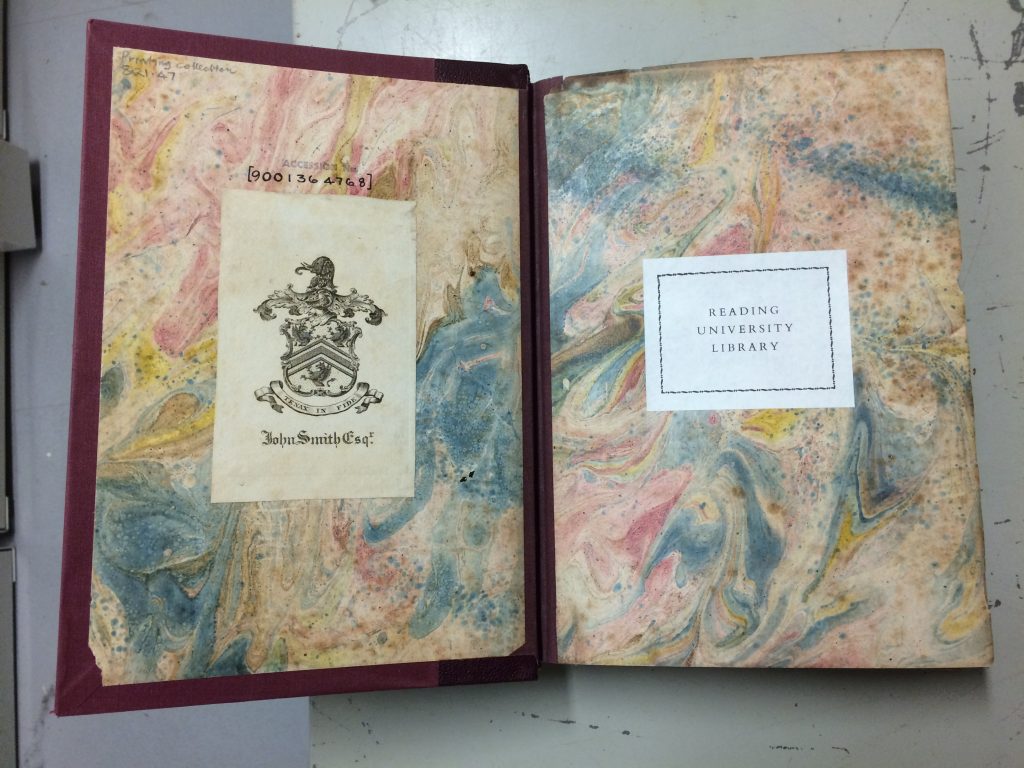Baskerville’s marbled papers
by Anna Murdoch, Graduate Trainee Library Assistant.
The Department of Typography & Graphic Communications’ teaching sessions always involve a swath of fascinating material from early medical texts to astronomy. One day I was setting up a large volume on some foam rests for students to peruse. Upon opening it up, I saw an endpaper quite unlike anything I had seen before. It had a much softer, lighter appearance than the richer, denser-looking examples found elsewhere within our collections.

The book in which these endpapers reside is Baskerville’s celebrated edition of The Holy Bible. This volume is part of the Overstone Library, a collection which has been held by the university for 99 years, having been bequeathed it by Lady Wantage. She was the daughter of the 1st Baron Overstone, who bought political economist John Ramsay McCulloch’s library after his death in 1864. Being the private library of a gentleman, many of the bindings are very fine. McCulloch, for his part, wrote in his preface to his library’s catalogue that he “acknowledge[d] myself to be an ardent admirer of well-printed handsome volumes […] I also confess to such a folly, if such it be, of being no less an admirer of well-bound than of well-printed books”. It is clear that not all of these bindings were executed during their lifetimes.
In his introduction to Anne Chambers’ The principal antique patterns of marbled paper, Bernard Middleton relates that marbling began to develop in England in the second half of the eighteenth century, which is the period Baskerville was active in. Diana Patterson relates the tale of his involvement in a competition for a premium offered by the Society for the Encouragement of Arts, Manufactures and Commerce, which is now the Royal Society of Arts.

McCulloch describes the volume as being bound in “old red morocco, gilt leaves ; a magnificent book”. Baron Overstone describes it as “Baskerville’s beautiful edition […] old red morocco extra, richly tooled, gilt edges”. In the latter catalogue there is a shelfmark written in pencil in the right hand margin: 11. A, and a note: “Marks. 1930” and additionally “£12 calf”. The shelfmark can be found in the book, but it is crossed out, as the book now sits at Overstone–Shelf 32J/04, and is deemed “Large”.
Both the catalogues and bookplates reveal this was a book Overstone bought from McCulloch. In Contributions towards a dictionary of English book-collectors, James Bonar writes that “the collection is not now traceable”. An inscription on the rear of the endpaper reads: 3/7. 38 453. This could be an acquisition date, or auction lot number. I have not been able to gather any more details on former owners prior to McCulloch.

One has to agree with McCulloch – it is a magnificent book. The binding is unsigned, but not without clues. One, on the exterior, is the leather label with the title on it in gilt. It certainly looks akin to Baskerville’s type. Philip Gaskell, writing of another binding, writes “what links it with Baskerville is the leather label on the spine… apparently with sorts of his own Double Pica roman and italic caps”. Gerry Leonidas, of the Department of Typography and Graphic Communiation, told me that he is not so sure about the lettering seen above as it “looks a bit heavy and with different proportions for the bowls of the B. The E and L have much more curved strokes leading into the serifs.” Another, also on the exterior, is the presence of an acorn tool, which according to Aurelie Martin in “The ‘Baskerville bindings’” is a finishing tool found on some of the 31 volumes she surveyed.
The third clue, when one opens the book, is the endpaper. Gaskell, in his Baskerville bibliography, describes an example of it as “rather striking […] marbled to represent blended washes of water colour”. Intriguingly, if one looks closely, you can see that two pieces of paper have been stuck together before being marbled. Diana Patterson asserts Baskerville did marble at least a ream of paper, which suggests there is more out there to be found.
This certainly is a very exciting discovery for us. Known examples of this marbled paper reside in Birmingham, the British Library, Harvard, and in private collections.
This is by no means the only example of this marbled paper we hold in our collections, but it is far and away the best. The second is in a rebound copy of Paradise Lost from the Printing Collection which only possesses its front endpaper.

Interestingly, this volume boasts a feature that the Bible doesn’t: marbled edges, revealing how watery Baskerville’s marbling was.

It is much less vibrant than, for example, this volume from the Overstone library:

There are many, many examples of different kinds of endpapers to be found in our rare books collection:
Sources:
A catalogue of books, the property of the author of the commercial dictionary, MDCCCLVI, London : [privately printed], 1856.
Bonar, James, ‘John Ramsay McCulloch’, Contributions towards a dictionary of English book- collectors, Bernard Quaritch, 1892-1921.
Catalogue of the library, Overstone Park, [s.l. : s.n.], 1867.
Chambers, Ann, The principal antique patterns of marbled paper, The Cygnet Press, 1984.
Martin, Aurelie, “‘The Baskerville bindings’”, John Baskerville : art and industry of the Enlightenment, Liverpool University Press, 2017, pp. 166-184.
Gaskell, Philip, John Baskerville: a bibliography, 1959.
Patterson, Diana, ‘John Baskerville, Marbler’, The Library, Volume 6-12, Issue 3, 1 September 1990, p. 212–221.
Pearson, David, English bookbinding styles, 1450-1800 : a handbook, London : British Library ; New Castle, Del. : Oak Knoll Press, 2005.